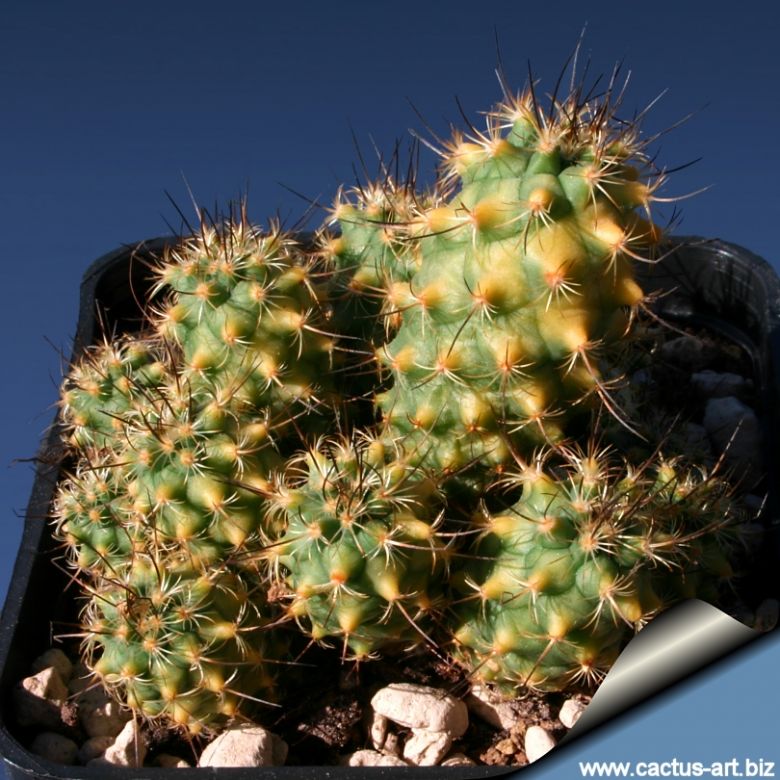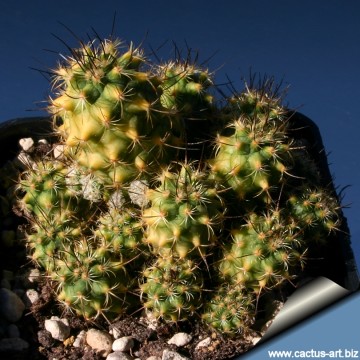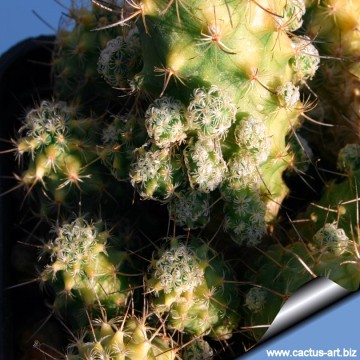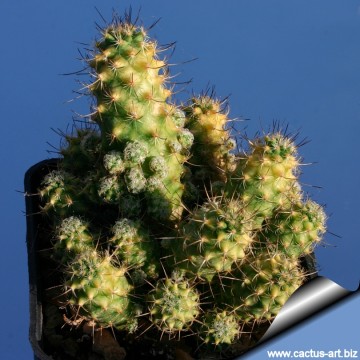
Turbinicarpus roseiflorus f. variegatus Photo by: Cactus Art
Synonyms:
See all synonyms of Turbinicarpus roseiflorus
Description: Turbinicarpus roseiflorusSN|11691]]SN|11691]] is a small solitary or copiously branching cactus with variable spination and also variable amounts of wool in the areoles.
Stem: Dark green, subspherical up to 3 cm tall, 4 cm in diameter. Crown white-woolly;
Tubercles: Rhombic, prominent tubercles, forming anti-clockwise diagonal spirals.
Areoles: Round, with white wool, later becoming naked.
Roots: Fibrous, copiously branching.
Radial spines: 6 to 13, of which the 6-8 lower ones much shorter, white, radiating sideways porrect, dagger-like, 3-5 mm long, while the 3-4 upper ones porrect and curving towards the apex, 10-15 mm long, black.
Central spines: 1 (to 2), porrect, slightly curved towards the apex, the lower part, mostly twice as long as the longest radial spine, black 1,5 mm wide flattened, black.
Flowers: Funnel-shaped, 2.5 cm long, 20 mm wide, petals pink , with dark mid-stripe on the reverse. Filaments greenish, anthers yellow. Style white with 4 short white club-shaped lobes. The white flowered form is also very attractive. Turbinicarpus roseiflorusSN|11691]]SN|11691]] "albiflorus"
Fruit: Oblong, to 5 mm long, at maturity brownish and dehiscing vertically.
Subspecies, varieties, forms and cultivars of plants belonging to the Turbinicarpus roseiflorus group
 Turbinicarpus roseiflorus Backeb.: It is a small solitary or copiously branching cactus with variable spination and also variable amounts of wool in the areoles. Flowers Funnel-shaped pink, with dark mid-stripe on the reverse.
Turbinicarpus roseiflorus Backeb.: It is a small solitary or copiously branching cactus with variable spination and also variable amounts of wool in the areoles. Flowers Funnel-shaped pink, with dark mid-stripe on the reverse. Turbinicarpus roseiflorus f. variegatus: Green yellow variegated stems. I will brach profusely to form small clumps.
Turbinicarpus roseiflorus f. variegatus: Green yellow variegated stems. I will brach profusely to form small clumps.
 Turbinicarpus roseiflorus f. variegatus Photo by: Cactus Art
Turbinicarpus roseiflorus f. variegatus Photo by: Cactus Art Turbinicarpus roseiflorus f. variegatus Photo by: Cactus Art
Turbinicarpus roseiflorus f. variegatus Photo by: Cactus Art Turbinicarpus roseiflorus f. variegatus Photo by: Cactus Art
Turbinicarpus roseiflorus f. variegatus Photo by: Cactus Art Turbinicarpus roseiflorus f. variegatus Photo by: Cactus Art
Turbinicarpus roseiflorus f. variegatus Photo by: Cactus ArtCultivation and Propagation: It’s a fairly easy and robust species to cultivate, but very slow growing. It needs a very well-drained soil, and requires strong sun to part sun to keep the plant compact and low and to develop a good spinal growth. Waterings should be rather infrequent to keep the plant compact, and avoid its becoming excessively elongated and unnatural in appearance. Furthermore it has a tap root, and watering it properly is often difficult, because it tends to crack open or rot if over-watered. Careful watering away from the body of the plant will allow the areoles to keep their wool. Keep dry in winter, or when night temperatures remain below 10° C. It is hardy to -4°C for a short period. Assure a good ventilation.
Reproduction: From seed, since the plant rarely produces plantlets, or grafted.














